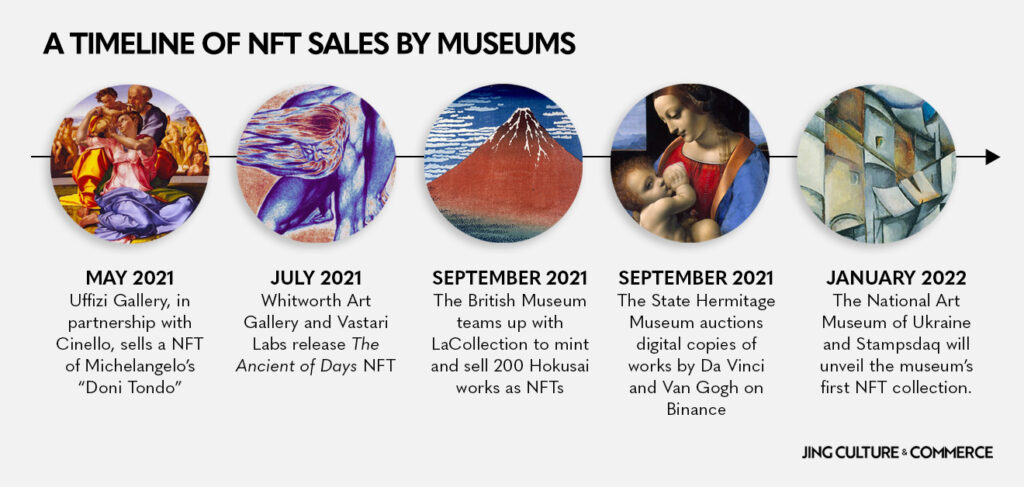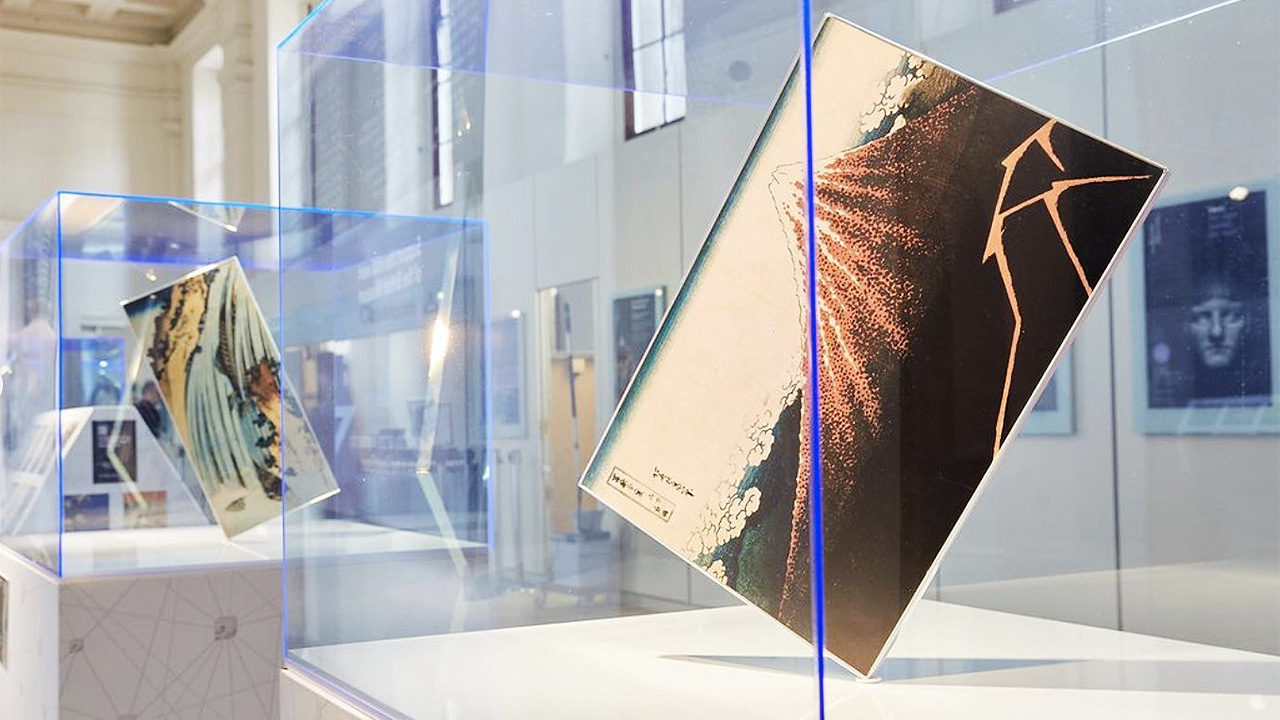Imagine the scene: as you mount the museum steps, a gargantuan Yayoi Kusama pumpkin blocks the entrance. You pass nonchalantly through it and find the foyer converted into a beguiling chamber of mirrors; a light hovers in one corner gesturing towards the main exhibit. The year is sometime after 2030; NFTs have transcended 2D screens and are ever-present across digital real estate.
The scenario may seem fancifully futuristic, but it’s one logical output of technology firms investing billions in metaverses and the status of NFTs as the go-to secure, transparent, and transferable digital asset. Museums may not be pioneering the NFT charge, but since the Beeple sale and frenetic blossoming of the art world’s newest movement, some storied institutions — from the British Museum to the Uffizi Gallery — have claimed a slice of NFT commerce.

Since mid-2021, a number of cultural institutions have sought out NFT platforms and technology partners to mint and sell NFT editions of works in their collections.
For NFT platforms battling to carve out a niche amid a rapid proliferation of competitors, working with high-profile museums gives them legitimacy as trustworthy marketplaces. For museums, NFTs as a monetization mechanism is tantalizing. “I don’t think museums see NFTs as the next great epoch or medium; they’re not thinking about starting a permanent NFT collection,” Elliot Safra, partner at AndArt Agency, tells Jing Culture & Commerce. “They see NFTs as a way to monetize their collections and assets, something they otherwise have a difficulty doing.”
Pandemic closures landed blows on the financial stability of museums. In the US, operating income has dropped 40 percent on average, forcing nearly two-thirds to cut back on education and public service programming — 15 percent may not survive, according to the American Alliance of Museums. The old model of in-person ticketing and event sales supplemented by mega annual fundraising galas has proven unsustainable, forcing museums to seek out new revenue channels.

The British Museum and LaCollection’s partnership saw the release of 200 Hokusai NFTs on the platform’s dedicated marketplace. Image: @LaCollection.io on Instagram
The prospect of generating funds through turning collection works into NFTs, though appealing, is misleadingly straightforward. In early 2021, NFTs minted by big names made money, somewhat irrespective of their long-term plans or pedigree in crypto circles, Safra says. Today, that gold rush has passed, as evidenced by the performance of the British Museum’s Hokusai sale through LaCollection — of the 200 auctioned works, only a handful have received bids.
Museums face a conundrum. Either they follow the money and strive to connect with longstanding devotees of blockchain, cryptocurrencies, and a digital art community typically beyond their horizons, or they can push to carve out a separate fine art NFT space for their traditional audience, one yet to fully buy into the promise of digital assets.
Connecting with crypto-native communities is likely a tall order, one requiring museums to loosen control and collaborate with platforms and digital artists with specific cultural clout. In the short-term, however, it may be their only option, says Bernadine Bröcker Wieder, Co-Founder of Vastari: “The NFT-buying experience remains relatively clunky and this activity is a way for museums to reach out to a new demographic rather than onboarding their existing demographic to Web 3.0.”
The longer-term project of bringing mass audiences into the fold — though doubtless aided by publicity generated by high-profile auction sales — will involve museums, NFT platforms, and artists educating people where they are. “I believe it needs to happen both online and through in-person exhibitions,” says Chris Cummings, Co-Founder of Iconic Moments, a museum-centric platform currently in conversation with more than 100 cultural institutions. “Introducing new people to the experience will involve NFT exhibitions using [special NFT artwork] frames and pop-ups.”
Set to launch in early 2022, Iconic Moments aims to work with cultural institutions to bring works in their holdings to the NFT marketplace. Image: Iconic Moments
Either way, the first step for museums is to clarify precisely what they are selling: a share in the original artwork, an official digital version (or “digital twin,” as the Uffizi put it), or something all together separate. Such transparency will allow audiences to gauge an NFT’s value and is fundamental, Bröcker Wieder says, partly because museums don’t differentiate between a physical work and a digital image in their own published materials. Failure to do so would be disastrous, says Fanny Lakoubay, a respected digital art curator and blockchain consultant: “A museum’s artworks are their only IP. They should be very careful about how they market and monetize them before they burn their assets.”
This speaks to the broader need for museums to align the NFTs they mint with their values and mission — something largely missing in the Hermitage, Uffizi, and British Museum drops. Better-rounded initiatives include the Whitworth Art Gallery’s The Ancient of Days NFT, which integrated a wealth of educational information, clearly outlined in its process and social purpose, and a project at the National Museums Liverpool, which invited locals to draw connections between a treasured personal possession and a tokenized museum object.

The National Museums Liverpool’s Crypto Connections project highlights how blockchain technology can reshape and democratize ownership. Image: National Museums Liverpool
Outwardly, at least, the platforms emerging to serve museums recognize the importance of being more than marketplaces through offering community and educational functions. LaCollection anticipates becoming the “leading cultural platform for art and tech enthusiasts,” says Jean-Sébastien Beaucamps, noting the word “NFT” is absent from their overall vision. It hopes to build in additional services such as webinars. Iconic Moments will emphasize the story, creators, and social impact behind each NFT to “amplify the mission of museums by cultivating a community that wants to support the arts,” as Cummings puts it. Stampsdaq, an Estonian platform that recently signed with the National Art Museum of Ukraine, employs digital artists to riff off collection works and integrates education games and play-to-earn contests to build community among users.
Ultimately, there’s nothing inherent or even obvious about pairing NFTs with a single work of art. In time, museums may well use NFTs to track provenance and conditioning, issue annual passes, or fractionalize collection works. For now, NFTs in the museum space are largely symbolic of an institution’s approach to the new digital, part of a broader revolution catalyzed by the pandemic. Those that build sturdy foundations will be better prepared for Web 3.0, whatever that may be.



